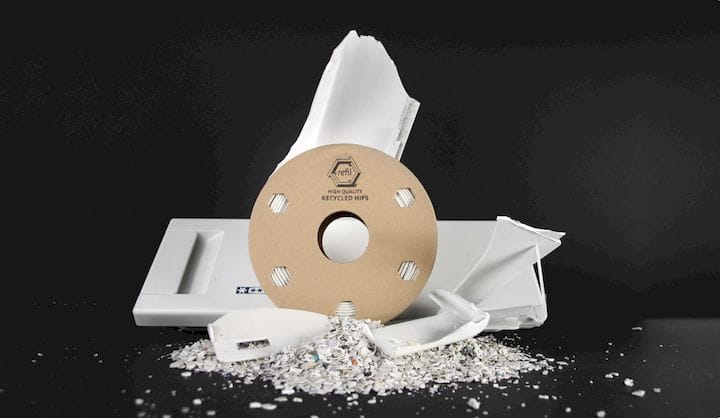![HIPS 3D printer filament made from recycled material [Source: Refil]](https://fabbaloo.com/wp-content/uploads/2020/05/image-asset_img_5eb0a417bcea5.jpg)
Refil announced a new recycled HIPS 3D printer filament, but its source is of interest.
The Netherlands-based company produces a line of recycled 3D printer filaments. Currently they offer PLA, PET and now they also offer HIPS, a popular 3D printing material that is sometimes used as dissolvable support: it can be easily removed by immersion in limonene.
I am usually quite skeptical of recycled filaments, particularly systems where one can supposedly produce 3D printer filament from random scraps, such as discarded 3D prints.
The reason for my skepticism is that in order to achieve quality 3D prints, one must use quality 3D print material. This material should be highly consistent in color, geometry (diameter) and also chemistry. If the chemistry varies, then the heating characteristics of the material change slightly. This can cause print quality issues, or even print failures in some cases.
Back to recycling. If you were to take random scraps and melt them back into filament, you would inevitably find the resulting filament to have mixed chemistry, as the scraps you fed in would no doubt be from different sources. It simply can’t work.
Well, recycled material filament can work if there is a consistent source. Refil (and a couple of other operations) have done so by constraining the source material. Imagine using only one brand of plastic bottles as a source material: they would all come from the same manufacturer, who more than likely used the same thermoplastic for all bottles. That’s a consistent source of recycled material from which you could produce predictably behaving filament.
That’s exactly what Refil does for PET material.
For HIPS they made a different arrangement. They partnered with Coolrec, a professional recycling company. Coolrec recycles many different types of equipment, including household appliances.
![3D print made from recycled refrigerator plastic [Source: Refil]](https://fabbaloo.com/wp-content/uploads/2020/05/image-asset_img_5eb0a4182a19e.jpg)
One of these appliance types is refrigerators. These common devices normally have very large thermoplastic liners made from – you guessed it – HIPS. The arrangement seems to involve Coolrec providing the liners to Refil, who chop them up and recycle them into consistent filament.
Refil CEO Casper van der Meer says:
“Making recycled filament may seem easy, but getting a steady supply chain and maintaining a high quality over different batches is a real challenge. This is why it took us several years of development to be able to guarantee the quality of HIPS. Together with Coolrec we’ve managed to realise this”
And that is the bottom line regarding 3D printer filament made from recycled material: It does not work unless you have a long-term source of highly consistent raw material.
Via Refil











An inventive designer has developed a method for producing 3D paper objects using recycled paper and 3D printed molds.